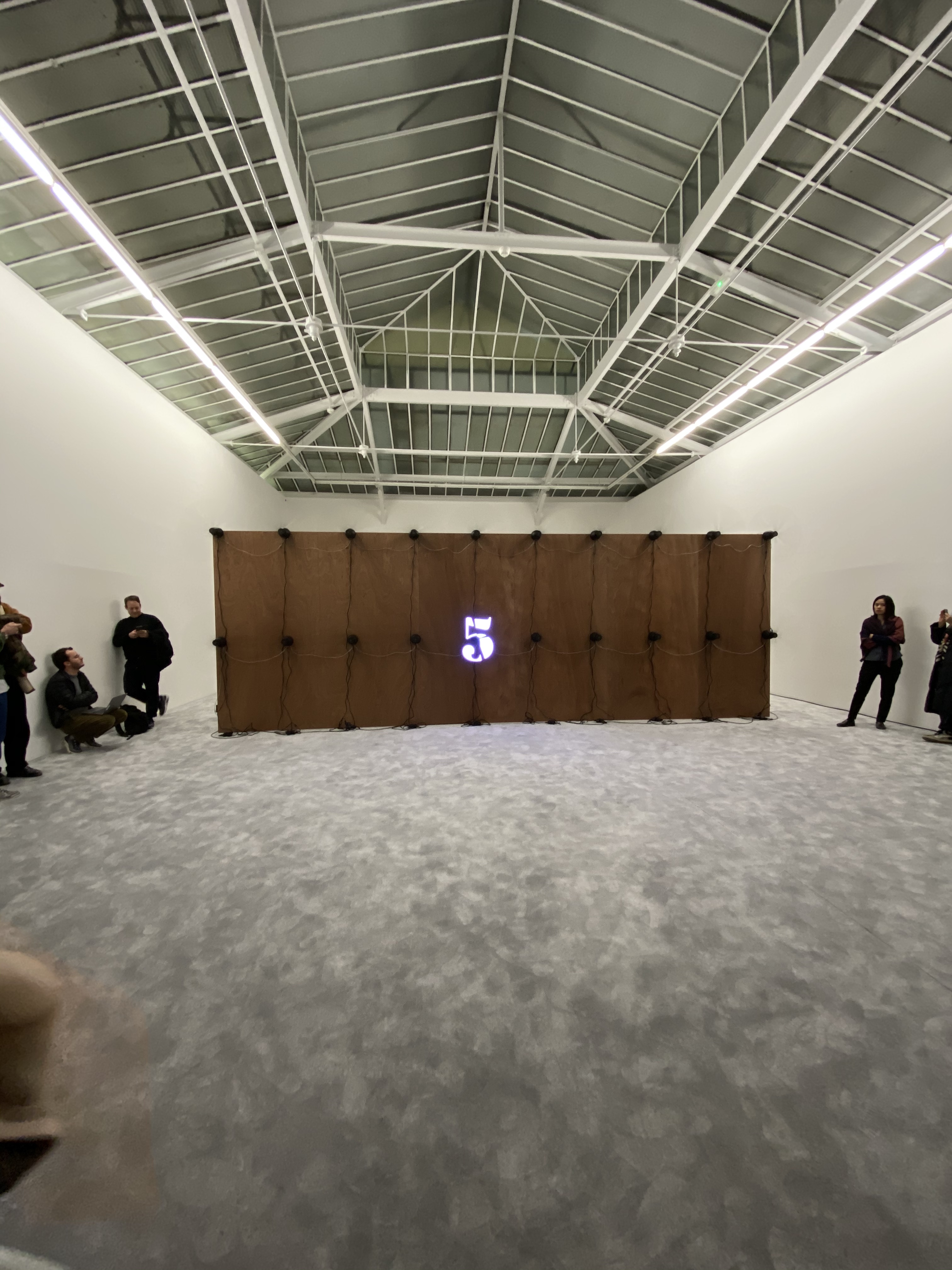Courtesy of David Zwirner.
An anthem of anxiety, a blague of technology: Wolfson exhibition falls short
By HINDLEY WANG2020-03-18 Paris
Standing in front of the giant holographic installation, as images of white faces painted in black and dressed in clown costumes flashed over and over, anger erupted in me.
The installation is in the HYPERVSN 3D holographic display, which consists of 20 image-conjuring fans mounted on a giant wooden wall, wires draping down and exposed to the viewers. Images and videos are formed on the spinning surfaces of the fans, accompanied by speeding sounds whining the proof of their labor. This is Jordan Wolfson’s fourth solo exhibition at the David Zwirner Gallery in Paris. It is titled “ARTISTS FRIENDS RACISTS.”
The setup is a reference to ’50s shop windows, with their lineups of TVs displaying news reports and advertisements—sometimes synchronized, sometimes delayed, sometimes slightly syncopated or disconnected. But the images here are elevated from their vintage state of confinement and displayed as if they are floating in the air.

These images, emblematic of the beginning of the World Wide Web, and often with their watermarks, occupy the spotlight in the center of the hypervision, along with videos of artificial intelligence machines at work and visuals of a bunny, a beating heart, a globe, an animated Star of David, with hands and feet, all dancing in multiplied forms. They draw you in, giving a promising appearance that invites you to wait and see what follows—only to find out there’s not much more past the first look.
Wolfson reveals an unbalanced interest in form over content, in the technology of the presentation rather than the artistic input. Perhaps his work demands the senseless deflection of its viewers. If there is any intellectual intention, it is reflected in this technology (the poor quality images from the last decade huddled together in a Windows 7 video player.
The only thematic thread stitching the images together was the three words in the title, in a bold 3D wordplay font that seeks to mimic the effects of crushed stones. These could be considered three titles for Wolfson himself: artist, friend, racist.
The artist-curator conversation did nothing to assuage the resentment Wolfson’s art stirred in me; if anything, his explanation angered me further. The conversation took place on Friday, Feb. 7, the evening of the Paris opening, right behind the installation—out of sight of Wolfson’s anxiety-inducing assemblage. The artist said the name of the exhibition came to him at a random moment, some time ago, somewhere in California, walking his dog or just staring at a glass of juice, just after he realized that he was racist. This is when a voice whispered to him, “Artists, friends, racists.” And then repeatedly.


Wolfson stressed physicality in the show—a common feature in his work, which often displays violence in the form of virtual reality, like in his show at the 78th Whitney Biennale. He seeks to translate the physicality of violence through extreme visuals, which speak to his previous works.
He asks his audience to investigate the visceral reactions inflicted by his work, which tries to induce or restore an “unobstructed” state. The positioning to which he assigns his audience is peculiar—a place of complicity with the “violence” he reenacted. But what if one does not want to be complicit to this display of media violence? Wolfson said he wanted to achieve a kind of “healing” through this art, but I took no healing from the ego oozing out of the HYPERVSN fans and I don’t know how anyone could be so egoistic.
The obvious ostentation is concealed in a well-assembled digital/technological display (“CGI animation, facial-recognition software, virtual-reality headsets, and advanced animatronics, among other cutting-edge technologies,” as the David Zwirner Gallery presents); since the very subject matter involves imagery in mass media, the ostentation can be easily overlooked by the spectators in front of the sophisticated display: “Oh it’s silly, but it’s cool… That is the point, isn’t it?”
What if it’s not the point? What if there is no point in this work, even if it’s displayed in one of the leading contemporary art galleries in the Western world; what if it’s just about him? A series of brass panels mounted with photos from Wolfson’s childhood, alluding to “ancient metallurgy, classical sculpture, and the radiant, gilded surfaces of churches and altarpieces from the Middle Ages”) adorns the entrance.
The exhibit, disappointing, under-serving and simultaneously enraging, is confused in Wolfson’s obsession with form. He entrusts too much in the technologies. Through the unsubtly symbolic and ineffectively political, Wolfson has at least one media phenomenon nailed down pat: cringe.
Wolfson’s bizarre conjunction of art and technology represents the dregs of the digital age. It is a kind of engagement with mass media that we do not need at the moment. By tuning into the process of careless mediation and meaningless recycling of images, “ARTISTS FRIENDS RACISTS” does not do much more than reenact the real violent onslaught of media: stating the obvious, over and over again, on the rare occasion when it says anything at all.
